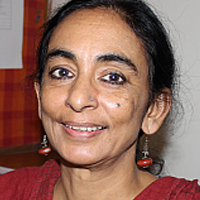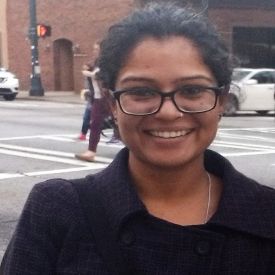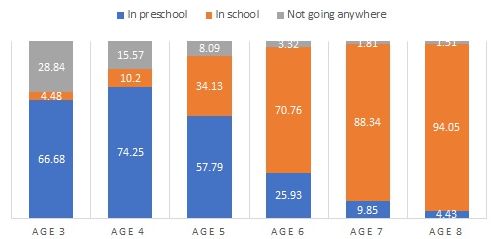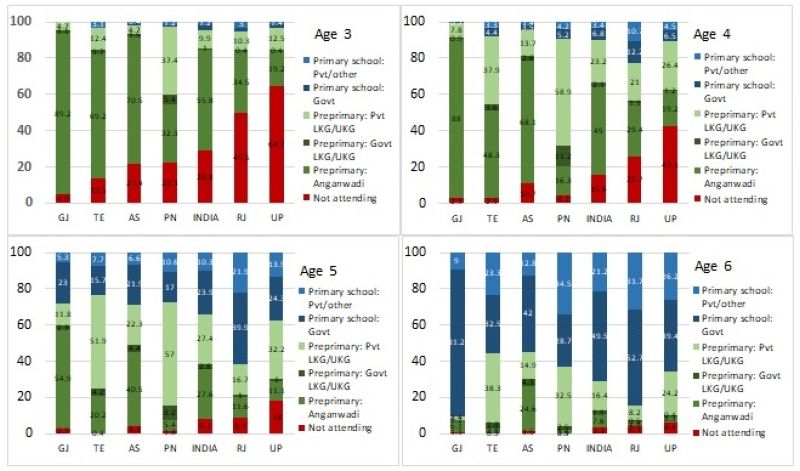This year’s Annual Status of Education Report throws light on what children in India do in their early years. In this article, Bhattacharjea and Ramanujan argue that the assumption that there is a universal, age-based trajectory that children follow from home to preschool to primary school is far from what happens on the ground. Children take different pathways through the early years that have consequences for what they experience and learn.
Adaptation is perhaps a key feature of the Annual Status of Education Report (ASER). Each year, while preserving the basic architecture of the survey, ASER adds new questions and domains in order to uncover and report new insights on the status of school enrolment and learning in the country.
Young children in ASER 2018
This year, among other changes, the ASER household questionnaire was modified to add to our collective understanding of what young children in India do in the early years. In previous ASERs, the questions we asked were guided by prescribed policy norms for children's participation. For 3- and 4-year-old children, we asked only about preschool enrolment. For children who were 7 or older we asked only about school (grade 1 and above) enrolment. Children aged 5 or 6 could be included in either category – preschool or primary school. In ASER 2018, we removed these restrictions. For all children aged 3-16, we simply asked whether they were enrolled, and if so, the school or preschool type and grade.
While this means that ASER 2018 enrolment data for 3- and 4-year-olds is not comparable with previous years’ data, we believe it will generate a more accurate picture of what young children in rural India are doing. We have observed over the years that the age-grade distribution in schools does not conform to policy norms, an observation that is also a major finding emerging from recent research conducted by ASER Centre and the Centre for Early Childhood Education and Development (CECED) at Ambedkar University Delhi (Kaul et al. 2017). The India Early Childhood Education (IECEI) Study, a first of its kind longitudinal study that tracked 14,000 children in three major states of India from ages 4-8, showed clearly that children take many different pathways through the early years, moving frequently between different preschools and schools as well as periods when they do not attend any institution. Moreover, these patterns look very different across states. In other words, the assumption in policy documents that there is a universal, age-based trajectory that children follow from home to preschool to primary school is very far from what happens on the ground.
Where are our young children? The national picture
There are currently two main avenues for accessing early childhood education in India. Far and away the most common provision comprises the 1.3 million Anganwadi centres2 (AWCs) run by the Ministry of Women and Child Development across the country under the Integrated Child Development Services (ICDS) scheme (Government of India, 2017). The other is the burgeoning private sector, with privately managed primary schools offering pre-primary LKG (lower kindergarten) and UKG (upper kindergarten) classes, spread across rural as well as urban India.2 A few states in India offer a third possibility as well, in the form of preschool classes integrated within government primary schools, for example in Assam, and Jammu and Kashmir.
Given this context, what were young children doing towards the end of 2018 in rural India?
Figure 1. Enrolment status of children from ages 3-8 in 2018
According to the Right of Children to Free and Compulsory Education (RTE) Act, enrolment in formal school should begin at age 6, with ECE (early childhood education) exposure recommended for children between age 3 to 6. However, 26 of India's 35 states and Union Territories allow children to enter grade 1 at age 5 (Government of India, 2014).3 National-level trends from ASER 2018 indicate that enrolment patterns broadly meet these policy prescriptions (Figure 1). At age 3, two-thirds of children were enrolled in some form of preschool while at age 6, 7 out of 10 children were enrolled in primary school. But we also see sizeable numbers of children in the 3 to 8 age group with unexpected enrolments. Even at age 3 and 4, a proportion of children are already in primary grades – about 1 out of 10 children at age 4. The same proportion is still in preschool at age 7, as is a small percentage of 8-year-olds. Corroborating findings from the IECEI study, we see that enrolment patterns only stabilise at age 8 when over 90% of all children are enrolled in primary school.
As with many estimates at the all-India level, these national trends hide major variations, not only between states but also with respect to the types of institutions that children attend within each category. The category labelled 'preschool' in Figure 1, for example, includes the three different types of institutions mentioned earlier: ICDS Anganwadi centres, private preschool classes and pre-primary classes in government primary schools. Each of these provide very different kinds of inputs and experiences for children. Likewise, the category of 'in school' children includes children going to government, private, and other types of schools; again, these differ in the kinds of environments they offer to children.
From age 3 to age 6, what children do varies enormously
A quick glance at the charts in Figure 2 provides a sense of how young children's participation in preschool or school varies, both across the country as well as at different ages.
Figure 2. Children's participation status in preschool/ school across the country, at different ages
At age 3, national policy recommends that children should be in an ECE programme. Gujarat comes closest to meeting the norm, with well over 90% children in some form of preschool, the majority in AWCs. In contrast, in Uttar Pradesh, almost two thirds are not attending anywhere. Assam and Punjab each have close to 80% children enrolled in preschool, but more than a third in Punjab attend a private preschool, while in Assam 70% are in AWCs.
At age 4, the proportion of children not enrolled declines substantially across the country. But the variations in what children are doing begin to multiply. For example, in Rajasthan, almost a quarter of all 4-year-olds are already in primary school – with almost equal proportions in government and private schools. In Punjab, while the majority of children enrol in private preschools, about 10% attend a pre-primary class in a government primary school. In Assam, about 7 out of 10 children are attending an AWC at age 4.
At age 5, nationally, fewer than 1 child in 10 continues to be out of school or preschool, and about a third of all children are already in primary school. In Uttar Pradesh, close to 2 in every 10 children are not enrolled anywhere. But in Telangana, more than half are in private LKG/UKG classes while in Gujarat, more than half are in AWCs. On the other hand, over 60% children in Rajasthan are in primary grades with a majority in government schools.
At age 6, although all children are expected to be in primary school, nationally, 3 out of 10 children are not yet at this stage. Over 40% of all 6-year-olds in both Telangana and Assam continue in some form of pre-primary class; while in both Gujarat and Rajasthan, over 80% children are in primary grades. But while in Gujarat almost all are in government schools, in Rajasthan almost a third are in private schools.
Implications
The varied pathways that young children take in the early years have major consequences for what they experience and learn along the way, both before joining primary school as well as once they reach grade 1.
In terms of children's ‘readiness’ to handle primary school content, the IECEI study demonstrated that neither AWCs nor pre-primary classes in private schools provide children with the opportunities they need to develop sound foundations. Early childhood education is one of six services offered by AWCs and arguably the least developed, given that a single Anganwadi worker is tasked with implementing all six services with little by way of training, resources, or support. While children in AWCs learn to spend time away from home and in the company of other children, there are few structured learning opportunities in place. Pre-primary classes in private schools, on the other hand, look much like primary school classrooms, with teachers focussed on (for example) rote-repetition of numbers without helping children to first understand the concept of quantity.
From the perspective of the primary school, children in grade 1 are far from homogenous in terms of age. ASER 2018 data show that nationally, more than a quarter of all children entering primary school are 5 years old or younger. Less than 40% are at the mandated age of 6 years, and a third are 7 or older. These age-grade distributions have obvious implications for teaching and learning. A 3-, 4-, or 5-year-old child is simply not developmentally ready to handle the grade 1 curriculum; the IECEI study, which measured children's school readiness and early grade learning, showed clearly that younger children are at a disadvantage. From the point of view of a teacher, moreover, teaching the same content to a 5-year-old as to an 8-year-old is not a trivial challenge. The requirement that teachers complete the curriculum for a given grade in a given year – and, by extension, that the children master the content being taught – does a huge disservice to both.
The enormous expansion in the numbers of children entering the education system has meant that there is much more diversity among children than was the case a generation ago. Neither pre-primary nor primary school classrooms are designed to address the issue of increasing diversity in the needs and characteristics of the children they cater to. The outcome in terms of learning is clearly visible. In the elementary school sector, ASER has demonstrated for more than a decade that getting all children into school, while undoubtedly a major achievement, does not by itself ensure that children are able to learn at the level prescribed by the curriculum. ASER data show that gaps between what children can do and what is expected of them emerge very early in children's school trajectories and widen as children move through the system. A quick look at the grade 1 language textbook in any state provides a good indication of what children are expected to be able to do when they enter primary school and the huge distance they are expected to travel during the first year itself. But in 2018, ASER data show that several months into grade 1, nationally, more than 40% of children are unable to recognise letters of the alphabet, let alone read words or connected text.
The challenge ahead
Extensive international research in disciplines as varied as neuroscience, psychology, and economics shows that early childhood – defined internationally as the age group of 0-8 years – is a critical period during which the foundations of lifelong learning are built. Ninety per cent of all brain development takes place by the age of 6. Giving children the kind of inputs and experiences they need in the early years has been proven to have positive effects not only on children's academic performance in school, but also on a range of social and economic outcomes even many years later.
Today, the importance of ECE is widely recognised internationally and is included in the Sustainable Development Goals (SDGs) for 2030 that were approved by countries around the globe, including India. SDG Target 4.2 states that by 2030 countries should ‘ensure that all girls and boys have access to quality early childhood development, care and pre-primary education so that they are ready for primary education’.
In India too, the importance of early care and stimulation has been recognised in the National Policy on Early Childhood Care and Education (Government of India, 2013), which aims to provide 'developmentally appropriate preschool education for 3 to 6 year olds with a more structured and planned school readiness component for 5 to 6 year olds.' These recommendations have been incorporated into the recently created Samagra Shiksha Abhiyan scheme of the Government of India, which has brought renewed focus and attention on ECE through the Integrated Scheme on School Education that aims to treat school education 'holistically without segmentation from pre-nursery to Class 12'. This scheme aims for greater coordination of services with the Ministry of Women and Child Development to focus on preschool education for children aged 4-6 years; states are encouraged to co-locate Anganwadi centres in government primary schools or else implement pre-primary classes of up to two years duration prior to grade 1.
The limited information available so far suggests that different states are putting different mechanisms in place in order to achieve this integration, which requires coordination not only between academic stages (preschool and primary school), but also between ministries and their respective structures on the ground. In this process, it is also important to take into account the differing contexts across individual states, some of which find expression in the different pathways that children take in the early years. A 'one size fits all' solution for young children is unlikely to be successful.
In both international and national policy documents, the key words are 'quality' and 'developmentally appropriate' education in the early years. The answer is not only to ensure that children attend preschool followed by primary school, but also to ensure that these provide environments that help children to grow and thrive. The continuum envisaged for the early years curriculum should start from and build on what children bring with them when they enter preschool and school; but so far, beyond the IECEI study that looked only at three states, little information is available on scale on children's 'school readiness' across the country. Perhaps this will be the question addressed by a future ASER.
This article first appeared in Annual Status of Education Report (Rural), 2018.
Notes:
- Anganwadis are childcare centres started by the Indian government in 1975 as part of the Integrated Child Development Services (ICDS) programme to combat child hunger and malnutrition. Anganwadi means ‘courtyard shelter’.
- According to the District Information System for Education (DISE) 2014-2015, 43.26% private schools in the country provided pre-primary classes. For more information, see Central Square Foundation (2016).
- These broad trends match quite closely with the findings of the IECEI study in the three states where it was conducted – Assam, Telangana, and Rajasthan.
Further Reading
- Alcott, Benjamin, Manjistha Banerji, Suman Bhattacharjea, Mansi Nanda and Purnima Ramanujan (2018), “One step forward, two steps back: Transitions between home, pre-primary and primary education in rural India”, Compare: A Journal of Comparative and International Education, DOI 10.1080/03057925.2018.1527214.
- Central Square Foundation (2016), ‘Pre-primary sections in government schools: Current Landscape and Recommendations’, August 2016.
- Government of India (2017), ‘Annual Report 2016-17’, Ministry of Women and Child Development, 31 March 2017.
- Government of India (2014), ‘Selected Educational Statistics 2011-12’, Bureau of Planning, Monitoring, and Statistics, Ministry of Human Resource Development, New Delhi.
- Government of India (2013), ‘National Early Childhood Care and Education Policy’, Ministry of Women and Child Development.
- Kaul, V, S Bhattacharjea, AB Chaudhary, P Ramanujan, M Banerji, M Nanda (2017), ‘The India Early Childhood Education Impact Study’, UNICEF, ASER Centre, Ambedkar University Delhi, New Delhi.




 29 March, 2019
29 March, 2019 







By: Kidzee Dhokali Thane 18 March, 2020
Great Post! Thank you so much. www.kidzeethane.com\r\n